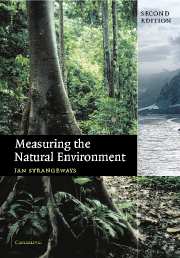Book contents
- Frontmatter
- Contents
- Acknowledgements
- 1 Basics
- 2 Radiation
- 3 Temperature
- 4 Humidity
- 5 Wind
- 6 Barometric pressure
- 7 Evaporation
- 8 Precipitation
- 9 Soil moisture and groundwater
- 10 Rivers and lakes
- 11 Data logging
- 12 Telemetry
- 13 Visibility
- 14 Clouds
- 15 Lightning
- 16 The upper atmosphere
- 17 The oceans
- 18 Cold regions
- 19 Remote sensing
- 20 Atmospheric composition
- 21 Forward look
- Appendix: abbreviations and acronyms
- Index
- References
3 - Temperature
Published online by Cambridge University Press: 05 July 2014
- Frontmatter
- Contents
- Acknowledgements
- 1 Basics
- 2 Radiation
- 3 Temperature
- 4 Humidity
- 5 Wind
- 6 Barometric pressure
- 7 Evaporation
- 8 Precipitation
- 9 Soil moisture and groundwater
- 10 Rivers and lakes
- 11 Data logging
- 12 Telemetry
- 13 Visibility
- 14 Clouds
- 15 Lightning
- 16 The upper atmosphere
- 17 The oceans
- 18 Cold regions
- 19 Remote sensing
- 20 Atmospheric composition
- 21 Forward look
- Appendix: abbreviations and acronyms
- Index
- References
Summary
This strange severity of the weather made me very desirous to know what degree of cold there might be in such an exalted and near situation as Newton. We had, therefore, on the morning of the 10th (December 1784), written to Mr —, and entreated him to hang out his thermometer, made by Adams, and to pay some attention to it morning and evening, expecting wonderful phenomena, in so elevated a region, at two hundred feet or more above my house. But, behold! On the 10th, at eleven at night, it was down only to 17°(F) and the next morning at 22°, when mine was at 10°! We were so disturbed at this unexpected reverse of comparative local cold, that we sent one of my glasses up, thinking that of Mr — must, somehow, be wrongly constructed. But, when the instruments came to be confronted, they were exactly together; so that for one night at least, the cold at Newton was 18° (—7.8 °C) less than at Selborne, and, through the whole frost, 10° or 12°.
Gilbert White. The Natural History of Selborne (Severe frosts).The variable
Only about 17% of solar radiation is absorbed directly by the atmosphere as it passes through it (Lockwood 1974). In fact the atmosphere is heated primarily as follows: solar radiation heats the ground and the ground’s heat is transferred to the air, firstly by molecular diffusion across the laminar boundary layer (a layer only a millimetre or so thick, which clings to most surfaces); beyond this, in the turbulent boundary layer, transfer is by turbulence, which is much more effective at transferring heat than is diffusion. Heat is also, thereafter, transferred by convection, bubbles of warmer air rising into the cooler air above. This transfer of warmed air away from the surface is the sensible heat flux. While it is difficult to measure the rate of energy transfer (see The eddy correlation method; Chapter 7), the resultant changes in air temperature are important and more easily measured.
Information
- Type
- Chapter
- Information
- Measuring the Natural Environment , pp. 31 - 52Publisher: Cambridge University PressPrint publication year: 2003
